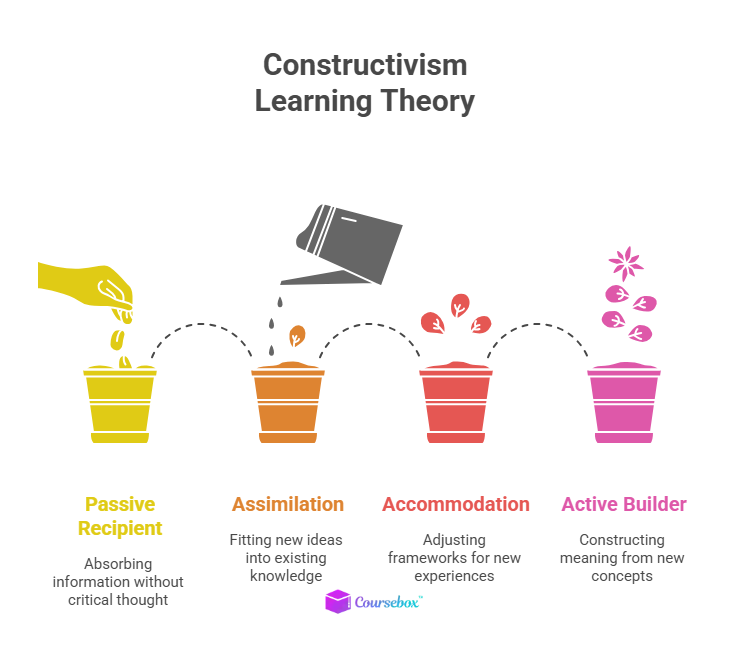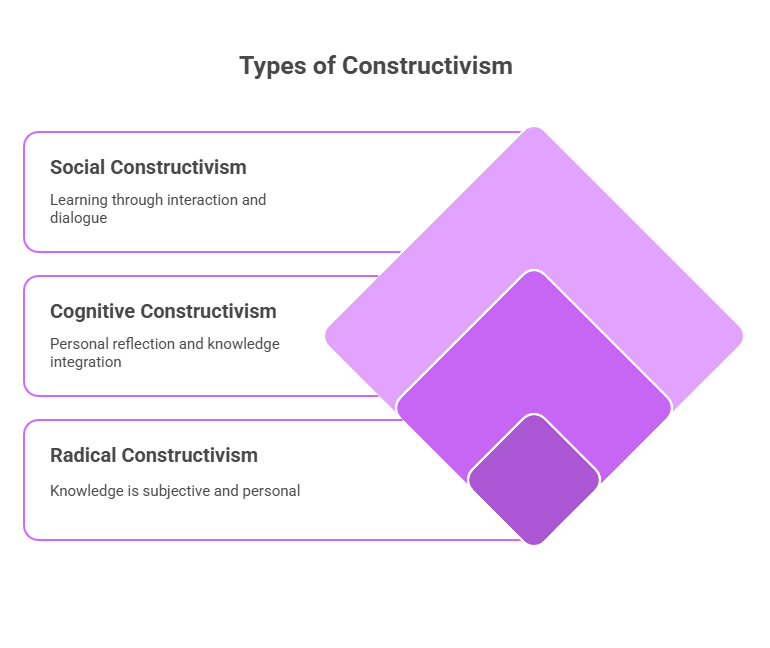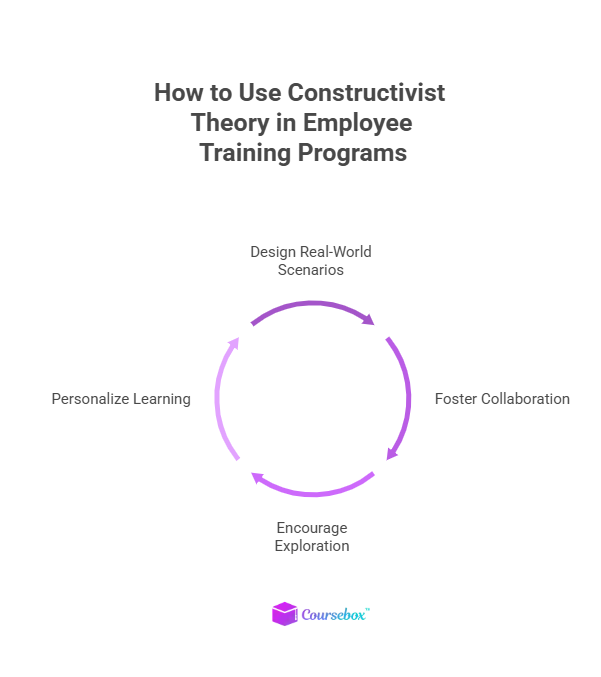Constructivism Learning Theory and Its eLearning Application
Constructivism learning theory holds that learners actively construct knowledge and understanding by building on their own experiences. Learn more here.
Constructivism learning theory holds that learners actively construct knowledge and understanding by building on their own experiences. Learn more here.

The future of learning doesn't lie in passive absorption but thrives in engagement and the power of experience. That's where constructivism comes in. It's a theory that places learners not as recipients of knowledge but as active participants in shaping it.
Constructivist principles offer a compelling framework for reimagining how we build eLearning environments. No longer are we limited to static slides or one-size-fits-all lessons, but with the right tools, we can create dynamic spaces that adapt to the learner and cultivate a lasting sense of ownership over knowledge.
The article explores how constructivism learning theory can open new doors in eLearning. We also cover scenario-based learning and adaptive technologies to show the practical applications of this approach.

Constructivist learning theory views learners as active builders of knowledge rather than passive recipients of information. Instead of simply absorbing facts, individuals construct meaning by linking new concepts to their existing knowledge base. Psychologist Jean Piaget described this as two complementary processes: assimilation, where new ideas are fitted into current mental frameworks, and accommodation, where those frameworks are adjusted when new experiences no longer align.
In practice, this means that learning is not a one-way transfer of content but an evolving process of sense-making. Knowledge is shaped by prior experiences, cultural context, and social interaction. Learners test ideas, encounter challenges, adapt, and refine their understanding over time. When applied to eLearning, constructivism shifts the focus from static delivery such as long lectures or text dumps to immersive experiences that encourage exploration, interaction, and inquiry. Effective courses include scenario-based tasks, real-world problem solving, collaborative activities, and opportunities for reflection. These elements allow learners to actively participate, draw connections, and apply concepts in meaningful ways.
Constructivism therefore promotes deeper engagement and long-term retention by treating learners as participants in their own knowledge creation rather than as empty vessels waiting to be filled.
One of the earliest and most foundational figures in constructivist thought is Jean Piaget, a Swiss psychologist whose work in the early to mid-20th century transformed our understanding of how children learn. Piaget proposed that knowledge is not a direct imprint of external reality on the mind.
Instead, he argued, learners build understanding through interaction with their environment. In his view, to "know" something is to actively engage with it and integrate it into one's mental framework. His emphasis on active construction laid the groundwork for modern constructivist approaches.
Later thinkers, such as Jerome Bruner, extended constructivist theory into the design of curriculum and instruction. Bruner advocated for discovery learning and spiral curricula that revisit key concepts at increasing levels of complexity. Even today, new constructivist ideas and practices continue to emerge, such as project-based learning and maker education.

Over time, educators and researchers have identified three major branches of constructivism. They are as follows.
Social constructivism places human interaction at the center of learning. Lev Vygotsky's work developed this branch for the most part. It argues that we learn best with and through others. Language, culture, dialogue, and shared experiences are the foundation of learning.

In simple words, learning is a social act. We co-construct meaning by engaging with others and negotiating and understanding together.
Cognitive constructivism shifts the focus inward. Influenced strongly by Jean Piaget, this branch views learning as a deeply personal, reflective journey. Each learner constructs knowledge by integrating new experiences with what they already know.
However, cognitive constructivism isn't to be confused with cognitivism. The latter views the mind as a machine that processes and stores inputs. On the other hand, cognitive constructivism sees the mind as an architect. It's constantly constructing and revising its own learning.
Radical constructivism, championed by thinkers like Ernst von Glasersfeld, pushes the envelope even further. It argues that all knowledge is subjective.
In this view, there is no single reality that can be transferred from teacher to learner. Instead, every person constructs meaning based on their unique experiences and interpretations. Educators act less like transmitters of truth and more like facilitators of inquiry. Students then question everything and form their own understanding.

Although there are different theories of constructivism, the following principles are common among them.
A major belief in constructivism is that knowledge is built, not handed over. Learners connect new ideas to what they already know rather than just absorbing information. As a result, their understanding shifts through observing and adjusting.
In a corporate learning environment, this would involve learners actively participating in activities that require them to apply new concepts and ideas. For example, marketers taking a course on influencer marketing will not just listen to theory. They will also use influencer marketing tools and case studies to create their own campaigns.
We don't learn in isolation. Conversations, group projects, peer feedback, and mentors are catalysts for deeper understanding. Constructivism recognizes that dialogue helps learners clarify ideas and see problems from new perspectives.
In our example, marketers would collaborate with their peers to troubleshoot campaigns. They may also learn from each other's strategies and share feedback.
Constructivists say that knowledge gains value when it's grounded in real-world relevance. Learners should be able to connect what they're learning to the world around them.
For example, marketers should not just learn about influencer campaigns. They must also be able to see how they support their broader digital marketing efforts and can help support the bottom line. The connection between concept and context helps the learning stick.
Constructivism emphasizes reflection as a tool for self-awareness and deeper comprehension. At the end of a course, learners should reflect on what they've learned and how it applies to their work and personal lives. The reflection helps them internalize their knowledge and make connections between different concepts.

Constructivist principles can make your employee training programs more impactful and effective. Here's how to use them.
The whole idea of constructivism is to tackle relevant problems. In employee training, this means designing activities that mirror real workplace scenarios rather than abstract concepts.
To implement this, generic modules should be replaced with case studies and role-play based on workplace situations. For example, instead of teaching "customer service best practices" through slides, create a branching scenario where employees must handle a frustrated customer and navigate through decisions with consequences.
Since learning in isolation limits perspective, constructivism encourages peer input and co-creation. Such training helps employees sharpen their thinking and discover new approaches through others' insights.
You can use group projects and peer mentoring in your employee training programs to foster such learning environments. For example, a cross-functional team can solve a mock business crisis together. This way, they build knowledge along with team cohesion.
In constructivist learning environments, mistakes are not setbacks. Instead, they are catalysts of learning and perspective-building. The goal isn't to get everything right on the first try but to experiment, learn, and improve.
Create safe spaces where employees can take risks without judgment. They should be able to share their ideas and test different approaches. You can then provide them feedback to refine their approaches.
When creating course material, develop learning paths personalized to your learners rather than trying to fit in as much information as possible. Allow for different learning styles, such as visual, auditory, and kinesthetic.
Some people may prefer watching videos or listening to podcasts, while others may benefit from hands-on activities. Similarly, you should incorporate adaptive learning paths or project-based assessments instead of standardized quizzes in your courses.
A prerequisite for this step is a feature-rich course builder that allows you to add all these things to your course. Coursebox fits these needs. From simulations to interactive elements and quizzes, you can add as many variations of learning experiences to your course as possible with this platform.

Plus, its AI course builder saves you a lot of time in the process. You can also use the AI assessment creator to develop tests for learners who prefer a more traditional style of evaluation. When learners find themselves stuck on a concept, they can also use the platforms' AI chatbot tutor as their real-time educator.
Constructivism offers a powerful lens for designing learner-centered experiences. However, it's not the only option.
For example, behaviorism takes a highly structured approach. It focuses on observable behaviors and external stimuli, using reinforcement to shape learning. In employee training, this might look like repetitive drills or rewards-based systems that reinforce correct responses.
Meanwhile, cognitivism moves beyond behavior to explore the internal mental processes involved in learning, like memory and attention. It sees the mind as an information process. The approach values clear structure and sequencing to accomplish learning.
On the other hand, humanism centers the learner's emotions and intrinsic motivation. It prioritizes personal growth, choice, and autonomy in the learning experience.
Which of these models should you choose for employee training? The answer depends on the context. For example, behaviorism may be useful for compliance training, while cognitivism works well for technical instruction requiring step-by-step mastery. You need to assess the situation and then decide.
Constructivist design in eLearning enriches learning by centering the learner’s experience through interaction, context, reflection, and collaboration. If you want to build courses that engage, adapt, and deepen understanding, Coursebox AI enables you to generate scenario-based content, adaptive learning paths, reflection prompts, and cohort analytics, all under your brand.
Want to explore how constructivist design plays out in real courses? Book a free demo today and see Coursebox AI in action.
Instructivism treats learning as transmission, where the teacher delivers facts and the student receives them. Constructivism instead views learning as an active process of building knowledge. Learners connect ideas to what they already know, test and revise their understanding, and reflect on outcomes. This shift from passive reception to active construction explains why constructivist methods often lead to deeper engagement and retention.
Assimilation is when learners incorporate new information into existing mental frameworks, making sense of it within what they already believe. Accommodation happens when those frameworks are reshaped because the new information does not fit. Together, assimilation and accommodation drive growth by balancing stability with adaptation, a principle central to constructivist theory.
Learning is strengthened when people articulate their thinking, hear alternative perspectives, and negotiate meaning together. Social interaction provides this opportunity, enabling learners to challenge assumptions, clarify misunderstandings, and refine knowledge in dialogue. Online courses that include group tasks, forums, or peer feedback reflect this principle by embedding collaboration into the learning process.
Apply constructivism in eLearning by using scenario-based challenges, project work, and reflection activities. Encourage learners to make choices, solve problems, and receive adaptive feedback rather than simply clicking through slides. Portfolios, branching case studies, and collaborative discussions are effective tools for translating constructivist principles into digital environments.
Constructivist learning benefits from platforms that support interactivity, collaboration, and adaptation. Examples include simulation tools, discussion boards, adaptive assessment engines, and scenario builders. Modern LMS platforms such as Coursebox also integrate these functions with AI content generation and cohort analytics, allowing organisations to design constructivist experiences at scale.
